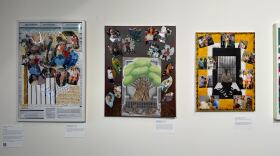If you’re traveling around Tacoma this month, you might see something that makes you smile. On the roof of the First Methodist Church, there’s a giant paper-mache megaphone and “I LOVE YOU ALL” spelled out in LED lights. This is one of 14 temporary art installations, created by public artists who received training and mentorship through the Public Art Reaching Community (PARC) program. Many of the artists are new to public art.
Gerardo Peña, who also goes by Periko the Artist, says the installation was a way for him to connect with people while respecting social-distancing guidelines.
“It’s a good way to reach out to people without physically being there,” Peña said.
Peña became a full-time artist last year after getting into a car accident that made it challenging for him to continue co-running a cleaning business. He decided to try pursuing his longtime dream of becoming an artist.
PARC is a collaboration between Tacoma’s Office of Arts & Cultural Vitality and Metro Parks. It’s intended to be a stepping stone for artists like Peña, who are interested in gaining entry in the competitive field of public art. It’s a free training for the selected artists, but estimates its value at $4,300.
The program began in April, shortly before the statewide stay-home order went into effect. “We were thinking of canceling it right when COVID hit,” said Rebecca Solverson, a public art specialist for the Office of Arts & Cultural Vitality who managed the program. “But that’s kind of why we decided to move forward with it is because we were like, ‘people are going to need this. People need artists to help us find new ways to be in community.’”
The program went forward in spite of Solverson — and other members of her office — being furloughed due to COVID-related budget cuts.
Elisheba Johnson, who oversaw the program as a mentor artist, was at the helm of figuring out how to quickly adapt what was supposed to be an intensive, in-person training into a virtual program. Additionally, there was the ongoing question of how to safely make public art in a global pandemic.
“Everything was changing at one point from week to week,” Johnson said. “So one minute, you (aren’t supposed to) touch the same surfaces as everyone else, but now we know it’s transmitted through the air, so wearing masks is crucial.”
As a safety precaution, some artists chose to create digital public pieces while others, such as Jessica Spring, stuck with the original intention of the program to create public art in parks. Spring, who has run Springtide Press in Tacoma since the late 1990s, created an interactive installation in a neighborhood playfield. Spring placed rolled up posters in the park’s chain link fence in the shape of a message: “YOU’LL HEAL TACOMA.” The idea was that people passing by might take a poster and swap it out with their own message.
Spring says she was skeptical that would happen, because as it happened, on the day her installation went up, wildfire smoke kept many people indoors. But to her surprise, when she came to check on the installation, about 20 people had taken posters and placed their own messages of healing — despite the poor air quality and safety restrictions around gathering.
“The fact that there were 20 more people that had come and responded was just completely amazing,” Spring said. “That puts the public in public art, right?”







